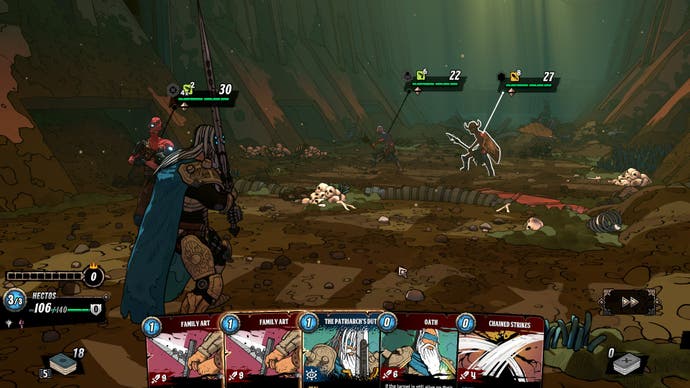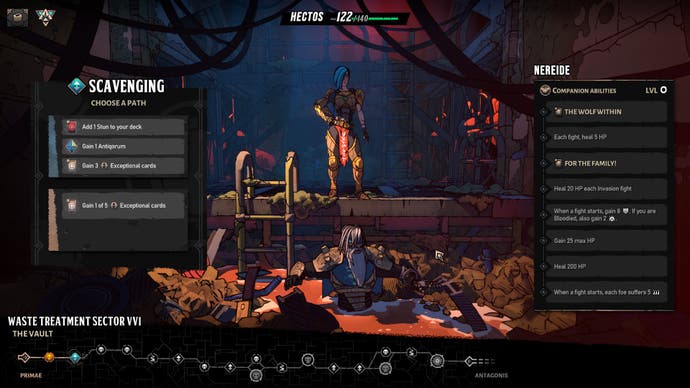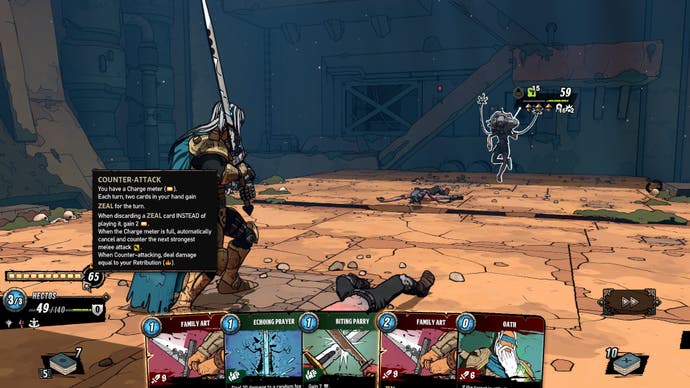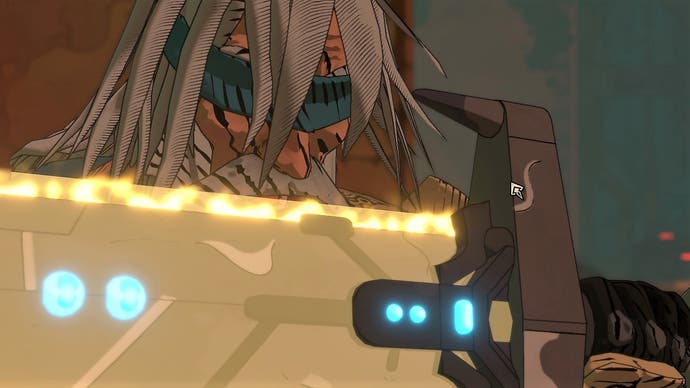Beneath Oresa evolves and beautifies the Slay the Spire experience
Cease your resistance.
Slay the Spire looms large over the Roguelike deckbuilding genre. Arguably, it created it, so it's hard to find a game here that doesn't copy it. Beneath Oresa copies it. You can feel it in the way you fight, the way you build your deck, the way you progress. Take all the Slay the Spire parts away and you don't really have a game. But that's OK, I think, because we've come to a point where Slay the Spire serves as a foundation for games to build on. And I find that exciting. And Beneath Oresa is why.
The first thing is that Beneath Oresa is big, in terms of file size. It's 4GB, a relative whopper. And I know you probably have flash-drives bigger than that - you probably had flash-drives bigger than that 10 years ago - but in the world of deckbuilding Roguelikes, that's big, like, dinosaur big. They're usually measured in megabytes.
What this means is that Beneath Oresa has graphics (no offence, Slay the Spire). It has proper 3D characters and environments, and swishy animations, and a cinematic eye (and camera) for using them. There's a moment of slow-down after you charge up to enemies and whack them, for example, as if the game's going, "Go on, do it again," so it can string together a fancy fight scene. And if you heed the call, the game can feel genuinely action-packed, which is an odd feeling for something like this, but I like it.
This extends to the sequences between battles too. These, you usually don't see. You just move along a map and deal with whatever the things are you arrive at. You don't deal with the in-betweens. But here, they're shown. Your characters run along like Batman and Robin through sewers, or whatever the environment is you're moving through - you are literally beneath the medieval-futuristic city of Oresa - and this doubles the immersion you feel from it. And even when you arrive at your destination, you see a depiction of what your characters do when they get there, like helping each other up a ledge. They are all very nice touches.
Characters, plural, by the way. Another major difference in Beneath Oresa is that you choose two characters at the beginning for your run, not one. But you only fight as one of them. The other comes as a companion and offers you passive buffs and cards depending on your Companionship level with them. Companionship is a separate progression path started afresh each run.
Another big thing: stages are broken into two fighting spaces, near and far. You can move between them while performing an attack, so you're not stuck, though it takes some foreplanning. Having two spaces means there's an opportunity to layer positional abilities in. For instance, some attacks will only work on enemies near you, or they'll do extra things on enemies far away, and there's a bunch of stuff you can trigger while you move between them. It's a whole other side of the game to think about.



And: counter-attacks. These can be really important. They offer you the occasional ability to completely block the strongest melee attack that round, and given how powerful some of these can be, particularly against boss-like foes, this is enormously useful. Then, you deliver a counter-attack. And again, these can be some of the strongest attacks in the game.
How often you can counter-attack depends on how quickly you charge a gauge, and how strong your counter-attack is depends on a number-counter you've been filling. Both, then, depend on what cards you've been playing. This is a key part of your strategy.
Those are the obvious things, and with them alone, Beneath Oresa feels sufficiently different. But there are less obvious things I really like too. One is a kind of feeling I get from the game in how it seems to favour dramatic battles rather than filler ones. There are smaller encounters in there but as you progress down beneath Oresa, they are less and less, and it's not unusual to encounter bigger enemies with hundreds of hitpoints of health (that's a lot in the game).
Even encounters with weaker enemies are spruced up with a reinforcement mechanic whereby many more enemies will rush into battle when the others are killed. It's a kind of turn-based horde mode, and it's exciting.

I like what Oresa does with card and deck upgrading and pruning, too. Just like Slay, you have five standard attacks and five standard defends, and a few other other cards, to begin with, and you add to them after each battle (I haven't seen the ability to skip a reward). But here, the deckbuilding stops on your route condense many more options into one.
Instead of having a separate place to Rest and heal or upgrade, and then events, and then shops, here, they're all rolled into one. You'll hit a downtime stop and be asked if you want to, say, upgrade a card and receive a bit of health and get an Antiqorum, which is the game's equivalent of a relic. Or would you like to increase your Companionship by one and remove a card and do something else? And I love this. Decisions feel much more valuable and chunky as a result. To me, it's an improvement.
And that's what Beneath Oresa feels like to me: a kind of evolution of what Slay the Spire does. I'm not saying it's better because I would never be so bold, and because I think Slay the Spire is a perfectly formed thing for what it is. I love it. But that doesn't mean it can't be altered, can't be evolved.

Beneath Oresa brings a style I haven't seen in this genre before, and a heady mix of strategy with it. Don't be fooled: this game is hard. You will need to really get to grips with all elements of it - companions, counter-attacks, positioning - before you get deep in the game. I urge you: read things carefully and think twice before you act, and be careful with the targeting because here, you target first and then you attack, not the other way around, and it's caught me out a few times.
And remember, it's still early-ish days. Beneath Oresa is just in early access, and plans to be there for another six-to-eight months, so here is when a lot of crucial tuning will be done. There's also still a chunk of content to come - new characters to play as, new enemies to defeat, new variables, new stuff. Not that it feels lacking in the few hours I've spent with it. I think It's clear already that Beneath Oresa is one to keep an eye on.


